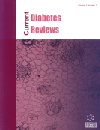-
s Insulin Glargine in Type 1 Diabetes Mellitus: A Review of Clinical Trials and Real-world Evidence Across Two Decades
- Source: Current Diabetes Reviews, Volume 20, Issue 1, Jan 2024, p. 27 - 41
-
- 01 Jan 2024
Abstract
Background: Over the past two decades, insulin glargine 100 U/mL (Gla-100) has emerged as the "standard of care" basal insulin for the management of type 1 diabetes mellitus (T1DM). Both formulations, insulin glargine 100 U/mL (Gla-100) and glargine 300 U/mL (Gla- 300) have been extensively studied against various comparator basal insulins across various clinical and real-world studies. In this comprehensive article, we reviewed the evidence on both insulin glargine formulations in T1DM across clinical trials and real-world studies. Methods: Evidence in T1DM for Gla-100 and Gla-300 since their approvals in 2000 and 2015, respectively, were reviewed. Results: Gla-100 when compared to the second-generation basal insulins, Gla-300 and IDeg-100, demonstrated a comparable risk of overall hypoglycemia, but the risk of nocturnal hypoglycemia was higher with Gla-100. Additional benefits of Gla-300 over Gla-100 include a prolonged (>24- hours) duration of action, a more stable glucose-lowering profile, improved treatment satisfaction, and greater flexibility in the dose administration timing. Conclusion: Both glargine formulations are largely comparable to other basal insulins in terms of glucose-lowering properties in T1DM. Further, risk of hypoglycemia is lower with Gla-100 than Neutral Protamine Hagedorn but comparable to insulin detemir.


